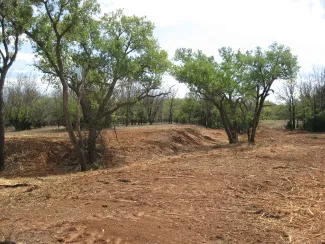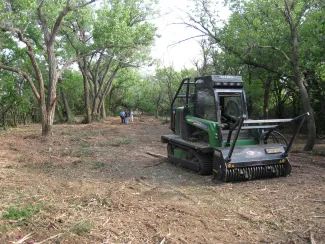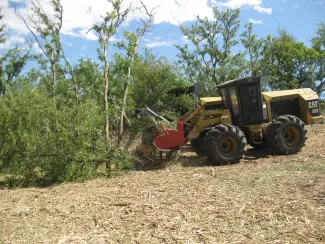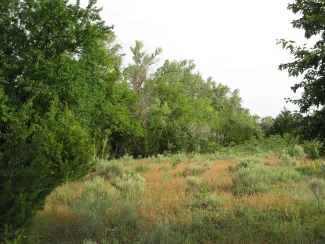From the Ouachita Mountains in the southeast, to the high plains of the Panhandle, Oklahoma boasts a wide array of habitat that is suitable for the three subspecies of wild turkey – Eastern, Rio Grande, and the Merriam - that call this state home. This diversity in habitat also brings a long list of suitable tree species that turkeys will utilize when roosting.

Maintaining roosting habitat is an important component of wild turkey management. (Jeremiah Zurenda)
All of these trees share similar physical traits. Roost trees are as tall or taller than most surrounding trees. They have a number of large horizontal branches that make for good perches as they roost. And the understory of these trees are thin. Shorter vegetation under and around roosting trees allows turkeys to identify threats or predators easier. A dense and taller understory can make a roosting turkey more susceptible to threats from below. As the understory around favorable roosting sites begins to fill in, these sites become less desirable to turkeys.
The eastern half of the state has no shortage of suitable roosting habitat. From the cross timbers east, suitable roosting trees are generally more abundant. But suitable roosting trees can be a limiting factor for turkeys in the western half of the state. Because of this, managing the understory of existing roosting sites can be critical to some of the more western populations of turkeys. This doesn’t mean we shouldn’t pay attention to roosting sites in eastern Oklahoma; managing roosting sites statewide will be beneficial to local turkey populations.
There are several methods that can be used to manage the understory of roosting sites. It can be as easy as using a chainsaw and the proper protective gear to remove the undesired brush. A chainsaw can be highly effective, but take your time and be aware of your own personal limitations while tackling a project like this by hand. The next option would be to use a tree cutting implement. There are a number of different implements for a tractor or skid steer that are suitable for cutting undesired brush. It is a good idea to remove the unwanted brush from beneath the roost trees after they have been cut. Mastication, or mulching, is another effective mechanical clearing method. The drawback to mulching implements is their price tag. Several contractors across the state offer mastication or forestry mulching, and may offer a more cost effective option for mastication around roosting sites.
Prescribed fire is a wonderful way to finalize the cleanup of the understory of your roosting sites. Fire is very effective at thinning understories. However, if the understory is too thick, roosting trees may get too hot and die while the underbrush around them burns. Because of this concern, it is a good idea to remove as much woody fuel as possible from underneath roosting sites before implementing a prescribed burn. Cedar trees and other woody species readily re-establish under enhanced roost tree sites and fire is an important tool to help keep this woody encroachment in check.
The following series of photos shows the progress of a turkey roost restoration project at Black Kettle Wildlife Management Area. The Wildlife Department partnered with the National Wild Turkey Federation to use a skid steer equipped with a mulching implement to remove brush from the understory of a young cottonwood grove. (Jeremiah Zurenda)
Contact your regional private lands biologist to get personalized guidance for improving your turkey roost habitat.



